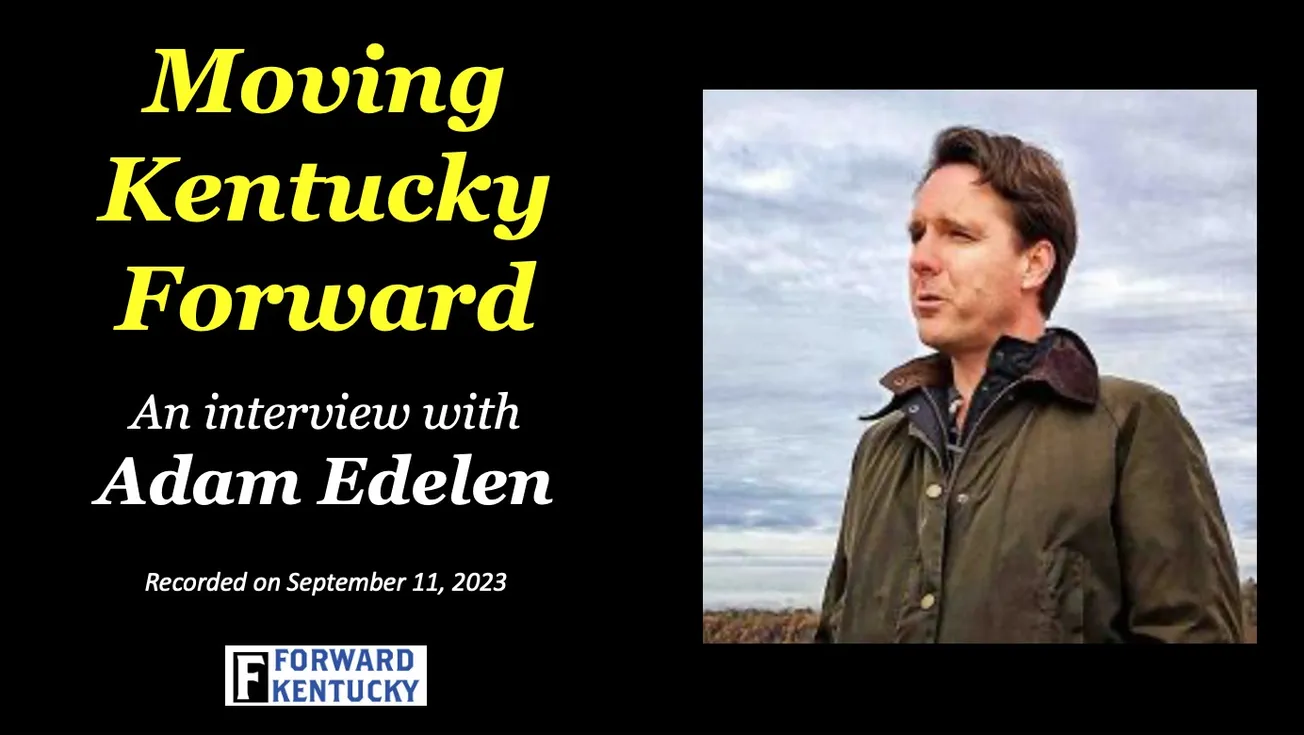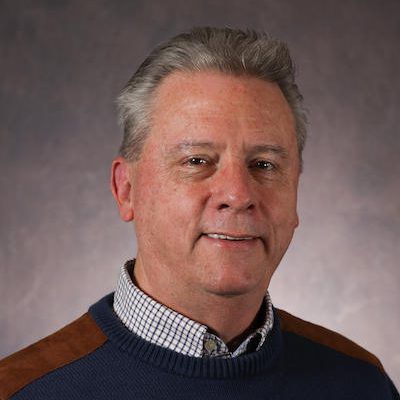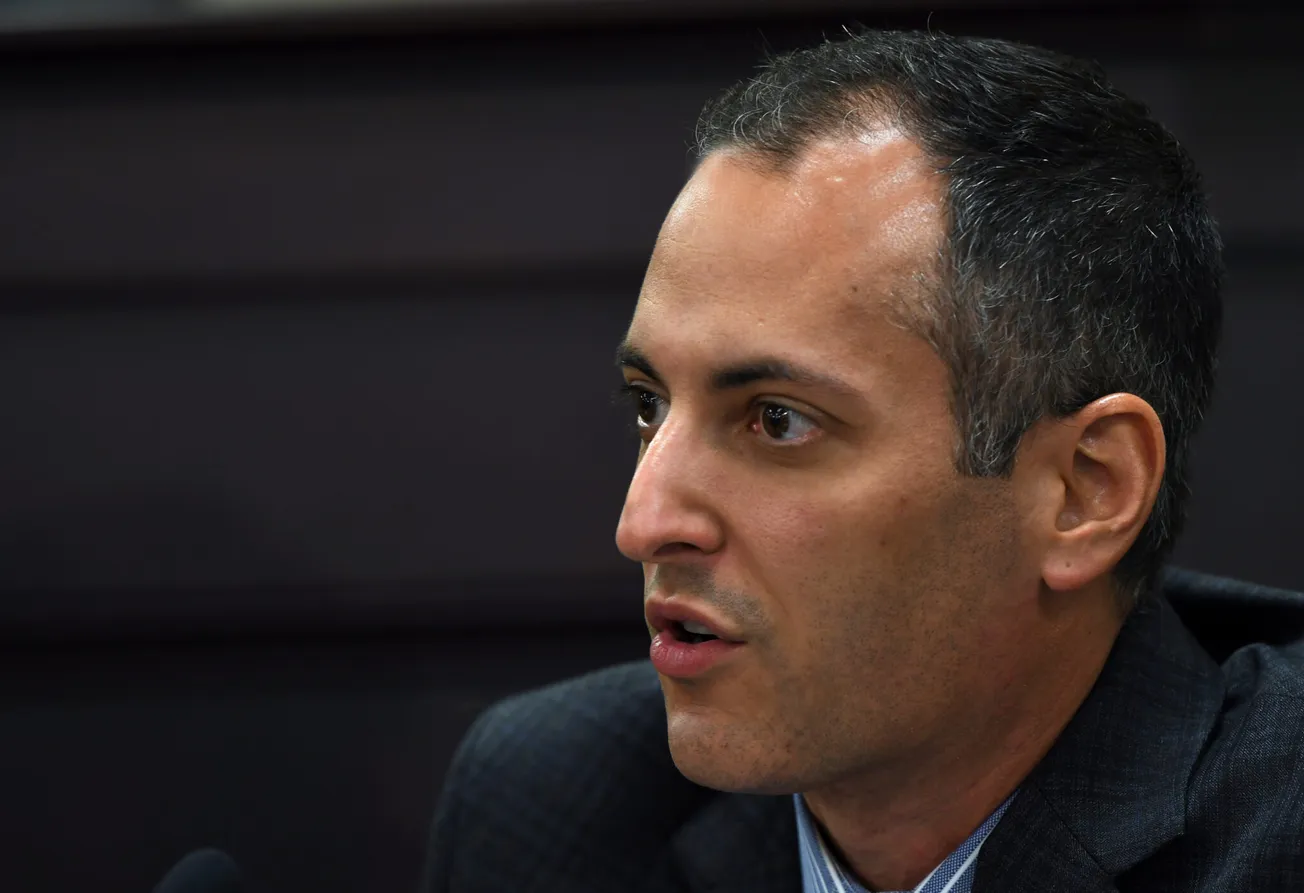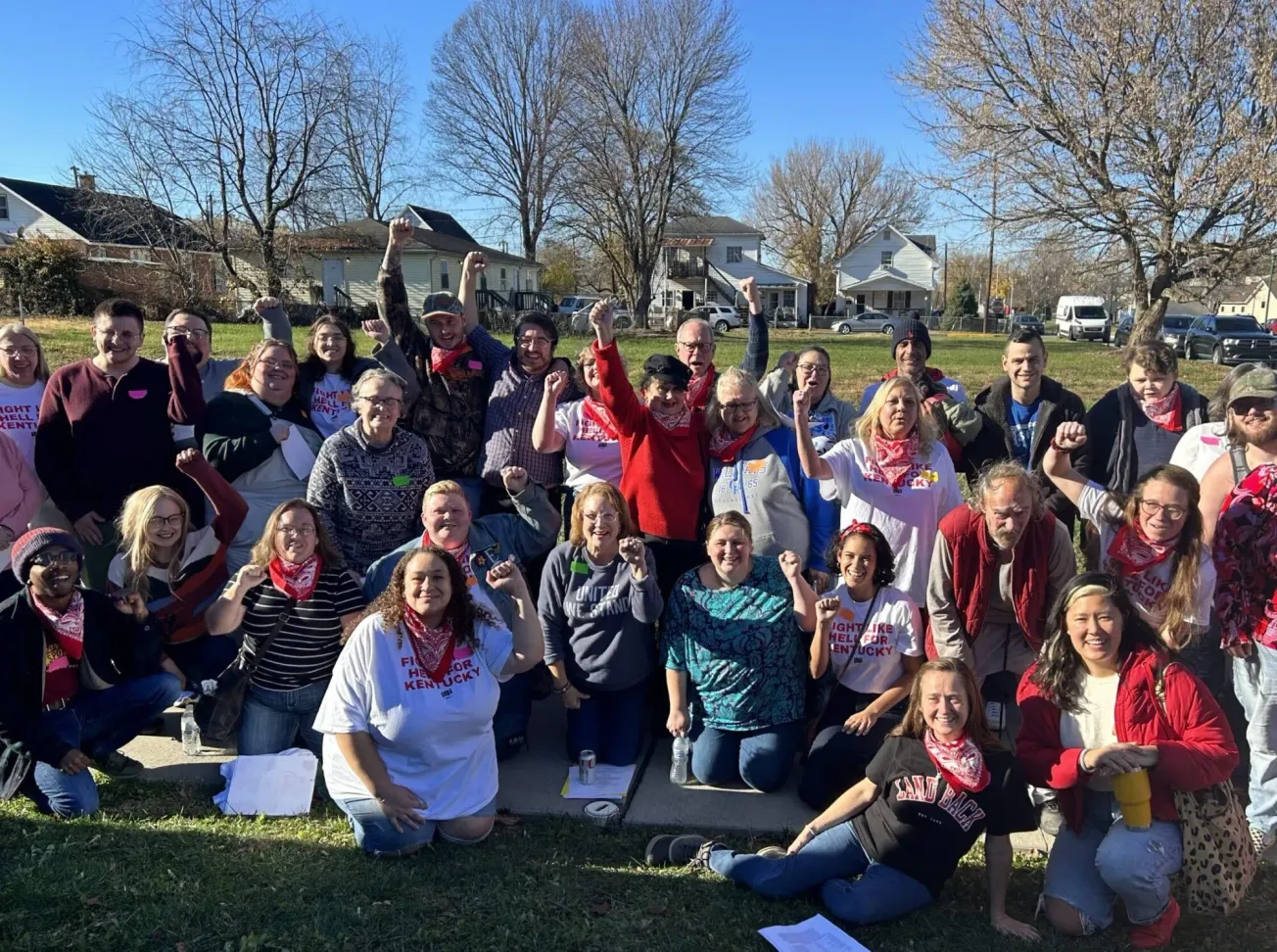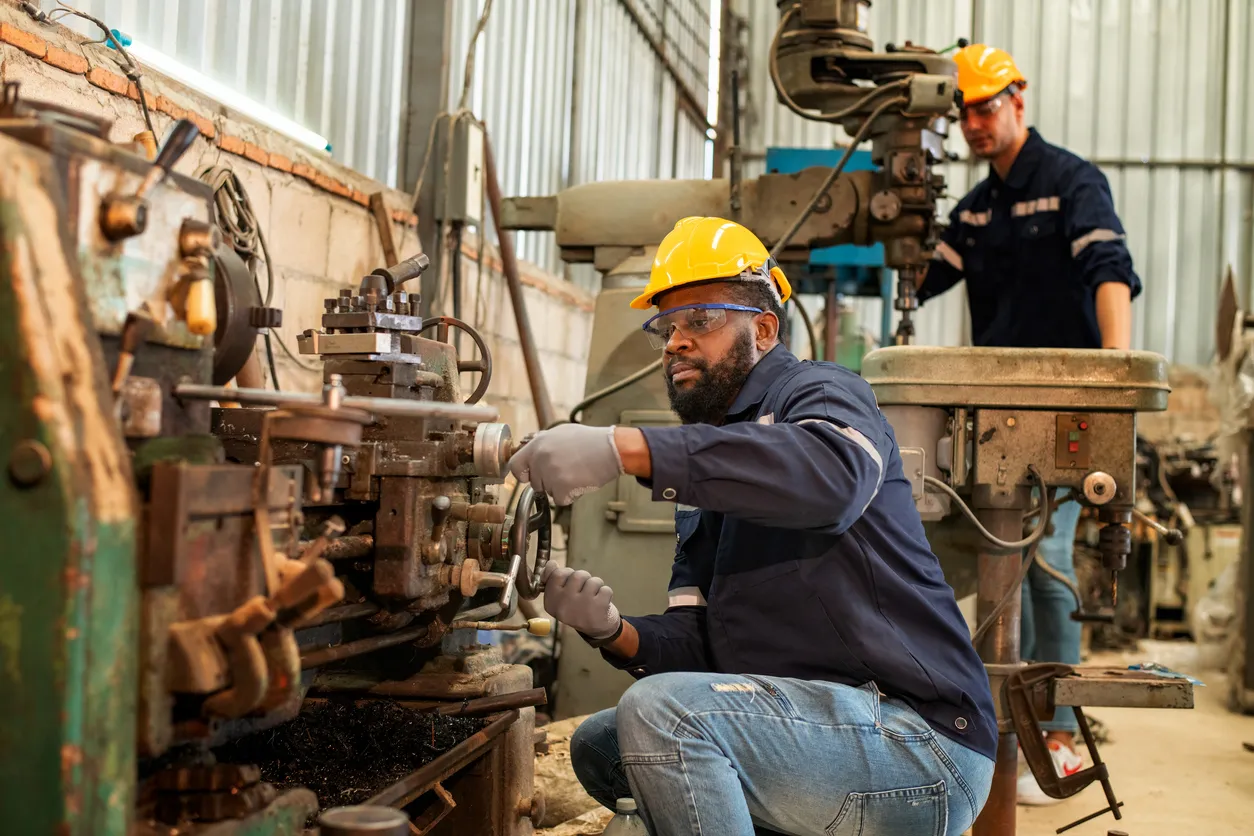We talk with Adam Edelen about his exciting project of building out solar arrays on the tops of mountains that had been flattened by mountain-top removal. He tells us about the jobs this is creating, who is buying the power, and the difference this can make for both the climate and the economy. Watch or listen to learn more!
(And remember, if you are a paying member of Forward Kentucky, you can read the transcript below the video and podcast.)
Transcript
Hello, and welcome to Moving Kentucky Forward. I’m Bruce Maples, publisher of Forward Kentucky.
Most of you probably remember that a little over four years ago, Adam Edelen was one of the candidates for governor running in the Democratic primary in our state. He lost, of course, eventually to Andy Beshear, who went on to win the governorship. After that, Edelen announced that he was beginning a project to do solar arrays on the top of mountains that had been flattened by mountaintop removal. The last I remembered seeing of that was him standing in a field talking about, you know, this was coming.
Well, a few weeks ago, I saw a story that it was happening, and that he was about to hire people to begin the construction of one. I just thought, what a great story, and why don’t we catch up with Adam and see what’s going on?
That’s what we’re doing. Today, we’re talking with Adam Edelen about the solar work that he’s doing. Let’s hear from Adam about his project.
We’re here today with Adam Edelen, who has served in state government in the past, has run for office, but now has another venture going. Adam, welcome to Movie Kentucky Forward.
It’s good to be with you, Bruce.
You know, I thought about starting this like those old-time movie serials. When last we left our hero, he was – whatever. So when last we left our hero, you were running for office.
I was.
That’s the last time I believe that we have interviewed you, and I know you’ve had some things going on since then. So as they say in the internet meme, why don’t you tell us how it started and how it’s going?
Well, Bruce, I appreciate it. It’s great to be back with you. And, you know, your outlet here is a great complement to the state. And I appreciate the deep dive that you do on important topics.
So when we were last together, I was a candidate for governor and I was running because I wanted to move Kentucky forward. I really wanted to bring 21st century opportunities to the state. And while that election didn’t work out, we built a company, Edelen Renewables, premised on the belief that we can bring the promise of renewable energy to the forgotten places of America.
And we have made a huge down payment on that mission recently with our Martin County solar project getting ready to go to construction. I mean, Bruce, this is a $231 million private capital investment at the heart of Appalachian coal country.
On 2000 acres of a mountaintop removal site, we’re going to build a massive solar array. The power has been purchased by Toyota. We’ve got up to 350 construction phase jobs with a preference for folks in Martin County and in others who have been displaced by the disappearance of the coal economy.
All of this about four or five miles from where Lyndon Johnson launched the war on poverty.
So, you know, what I’ve learned is you don’t have to be an elective office to build the future. You’ve just got to have a mission for doing it and a clear vision and a lot of focus on doing the hard work to make these big things happen.
When we have talked about this in the past, I went back and looked for it, couldn’t find it. I seem to remember talking with you about this a long time ago, and then I saw a story about it some time ago that was basically you standing in a field.
Yeah.
And I thought, OK, you know, this may happen. Let’s hope it does. And so I was very excited when I saw a story about you recently that said what you just said. OK, we’ve got the investment and even more important, we’ve got the power purchased.
Correct. We know not only how we’re going to make it, we know how we’re going to sell it. And so we’ve got a business plan and so on and so forth.
How did this come about? Obviously, you can’t share a lot of details, but what made you think about that location and what made you think about Toyota as a purchaser?
Well, when we began the process of, well, it actually goes back further than that. I’m at my core a problem solver, Bruce. And when you look at the endemic poverty that we’ve got in Appalachia in general, in eastern Kentucky specifically, and our mindless politics have offered nothing but rhetoric. And if you’re going to solve a problem, you have to do real constructive things.
And so I began to think about Appalachia and its historic role as an energy producer. I mean, let’s be very clear, the coal fields of eastern Kentucky literally powered the industrial development of this country for 100 years. It provided both the men and material and energy to win one, not one, but two world wars. And so we owe these people a debt. And it is a uniquely American debt. So how do you begin to square the deal with the very people who powered the industrial development of the old economy?
Well, you do it by including them in the new economy. And Bruce, let’s be clear. It may not be fashionable to talk about in Kentucky, but it is in the entirety of the rest of the world, is that the green energy revolution is the greatest economic catalytic event. It is the greatest wealth producing event in our lifetimes, with the possible exception of the advent of the internet. And so how do you seize the opportunities that are created by these catalytic moments in our history, where you see this confluence of economy and technology and culture?
And I saw it. And so the question is, as a leader in Kentucky, whether in the public or the private sector, how do you put people in the way of progress? And the way we do that is reimagining Appalachian Kentucky as an energy producer, which is their historic role, for the next hundred years.
And so as we got into this, the things you need for large scale solar development is you need a lot of flat land. And we’ve got a million acres of mountaintop removal sites in central Appalachia. You need access to high capacity transmission lines. And Bruce, not a lot of people realize that it took a hell of a lot of power to power the coal industry. These were electric operations. The drag lines were electrically run. So you’ve got this incredibly robust transmission infrastructure built all over Appalachia that now has nothing on it because there’s no power being used at the other end. Well, we can repurpose these lines to carry green electrons that we manufacture in Appalachia to the population centers of the Northeast and the South and the Midwest. So it just seemed like this could be a natural, massive opportunity to do a big, important thing.
And so as we built out this, we were able to attract really smart people, well capitalized, who wanted to help us bring life to our vision. And Toyota was the first heavy manufacturer on the planet to create a 100% sustainability goal. They did it seven or eight years ago. It literally changed the industry. Now, nearly everyone in the Fortune 500 has a sustainability goal.
And Toyota is a great corporate citizen. So we began partnering with them to do what is the first large-scale coal-to-solar project in the United States, and certainly the first in Appalachia, to repay that debt. And so Bruce, we’re weaponizing capitalism to bring opportunity to places that haven’t seen it in a long time.
And the mindless rhetoric about the war on coal, certainly even coal companies with whom we’re partnered will tell you that what fought a war on coal was natural gas. It was the private sector, right? So we have to think about what’s next. And what was deeply frustrating for me out of my personal story was that, as you know, I’m a kid from Meade County whose family are all tobacco farmers.
And government did a really good job at the state and federal level of planning from the transition away from the tobacco economy. My dad took the buyout the year after I went to college. And as a result, our agricultural communities are substantially better off than they were 25 years ago.
We have utterly failed. And this is a bipartisan failure, Bruce. I mean, I say this as a Democrat. You know, Frankfort Democrats have been as empty-headed as Frankfort Republicans about planning for economic transition and diversification in Appalachia. And the truth of the matter is it’s better run from the private sector, because while you’ve got Frankfort at its best, it’s leaving us alone as we’re trying to build a green energy economy. At its worst, it’s a terrible hindrance.
But the market has voted. I mean, Bruce, we had at our first jobs fair in Inez just last Thursday, we had nearly 500 people show up. It was incredible. You’ll be reading about it a lot in the national news. This is an incredible moment in our history.
And while it’s not the only solution, we’re going to have to let a thousand flowers bloom. This is an important part of bringing economic diversification to the coal fields.
So I was interested with something you just said. You said partnering with coal companies. I would sort of assume that they would be, I don’t want to use the word enemies, but not necessarily sympathetic to your program. Tell me about partnering with coal companies.
So, Bruce, you know, my career in Frankfort and in public service was always predicated
on a belief that you don’t have to agree on everything to work together on something.
And, you know, not just the project in Martin County. We’ve got more than a half dozen others. And every one of these projects, there’s a coal company involved. And that’s because, you know, their motivation is to monetize a stranded asset.
These abandoned mine lands are good for nothing other than maybe seeing a couple of elk and paying property taxes. And so what these coal companies have recognized, if they can be part of continuing to be an energy company and being in the green energy space and create a profit, that they’re all on board.
And so I’m passionate about this work because I want to create jobs where there aren’t many. And I want to save the planet. It doesn’t matter to me what my partner’s motivations are so long as I can accomplish that goal.
And I think it’s proof positive from the mess we see in Frankfort to the mess we see in Washington that we are not nearly as divided as we’re being led to believe. The problem is that we’ve got, by and large, talking point politicians, Bruce, who lack innovation and creativity. And you can always structure a deal that works for multiple parties. And if you are that kind of leader, you can accomplish big, important things. And fortunately, our team is helping drive this in some important places.
So you mentioned 200-and-something jobs, 278, I think is what you said, which is for the construction. Now, unlike hydroelectric dams or other types of energy producing things, solar, once it’s built, just basically sits there and does its job. So I can’t imagine that you’re going to need very many people to monitor it once it’s built. So what’s the construction timeline look like and how many jobs will you have once the construction is done?
So it’s 350 jobs during construction. And because this will be built out over two phases, that will be somewhere between two and three years. And you’re exactly right that the employment level for a fixed site isn’t significant. We’re talking maybe a dozen jobs. But that’s why we have worked so hard in an approach that we have trademarked called Social Impact Solar, where we have partnered with the community and technical college and all the workforce and economic development agencies in the area, as well as the labor unions to reimagine solar construction as the first or second rung on a ladder of economic opportunities. So the people who work on our project will have the opportunity to earn a skills credential that is both stackable and portable, which means they can be spun off into union apprentice programs. They can follow workforce development strategies that are in place from the community and technical college system. Or they can work on other projects that I’m developing in the area.
And just so your listeners and viewers, Bruce, understand that this isn’t a one-off, we now not only have proof of concept in Martin County, but you may have seen their recent announcement about the involvement of the EV automotive manufacturer, Behemoth Rivian, agreeing to buy the first tranche of power that we produce at Starfire.
And so folks from eastern Kentucky will recognize Starfire because like Madonna or J-Lo, it’s known by a single name in the coal industry. And it’s 7,200 acres. That was the largest land acquisition for a renewable energy project in the United States. It’s so big that it encompasses Brethitt, Perry, and Knott counties. So the level of workforce participation we’re getting from all these elected officials, Republican and Democrat, to do these big, important projects has been profound. But Rivian is going to buy the first tranche of that project. We think it will go to construction in 26.
We have another one in eastern Kentucky that could go to construction in 25. So what we’re creating here has really taken hold and it’s become a massive initiative. And so building up the workforce for what is the fastest growing sector of the global economy is a big deal. So what we know is that everyone in rural America travels for work. It’s the reality of the situation.
But we can create the 21st century green energy skilled workforce of the future here. And as a result, they will magnetize other opportunities.
So Kentucky is currently dead last in green energy production amongst the 50 states. That’s not an accident. That’s a policy. It’s not a policy failure. It was a policy decision.
But we’re going to change. We’re changing that narrative regardless of what the politicians of either party think. And when you hope for 100 people to turn out in INES for a job fair and you instead get close to 500, that tells you where the folks are. And so while our politicians may not be as aggressively building the future, I can tell you that the appetite for new opportunity is amazing in coal communities.
And we’re not just in coal communities. We’ve taken our company nationwide. We’re in 13 states. We’ll have an announcement soon about a project in Hobbs, New Mexico, which is the heart of the oil and gas producing area known as the Permian Basin in eastern New Mexico.
We’re doing this all over the place because we think that given this enormous gravitational opportunity with the green energy economy, we can widen the winner’s circle to include a lot of people who’ve been left out of the new economy.
So I wanted to ask you, I understand now why you’re partnering with coal people because they own the land. What are the utility companies saying to you? I know that at least around here, people who have tried to do solar larger than an individual home, if they tried to do community solar or something like that, they’ve had LG&E and KU come to them and say, no, no, no, no, we do solar. You don’t do solar. What are they saying to you about this project in Martin County and your other projects?
So fortunate for us, Kentucky is part of a regional energy grid in what’s called a structured energy market. We are a member of the PJM, which stands for Pennsylvania, Jersey, Maryland. Geographically,
it extends from the New York state line through the mid-Atlantic states into Virginia, down to the Carolinas, cuts across central and eastern Kentucky, and then goes to Chicago.
And it’s the world’s largest energy market, and it’s one of the very few that has such a significant gap between its demand and its supply.
So in a structured energy market, the utility cannot tell you No, which is great; unlike deeper south where you’ve got the TVA and the southern companies who have more latitude to determine the outcome of these projects.
LG&E, KU, our Kentucky-based utilities, they don’t have the ability to say no. They are a valued partner because we rely on them to connect to the grid.
What I will say about the utilities in Kentucky is that they have historically been laggards, but they are getting the message. Things are improving. I can tell you the fantastic work that’s been done to bring the EV battery facilities to Kentucky is you can’t embrace new economy, green energy-driven manufacturing like Blue Oval and the Korean facility and Bowling Green and not recognize their demand for green energy. And that is to say all of these companies have a 100 percent sustainability goal. And if Kentucky is going to remain relevant to 21st century economic opportunities, we’re going to have to be able to source green electrons for these guys. And that’s why you’re seeing the utilities shift. It’s an appreciation of market reality.
Bruce, I cannot underscore enough how far the politicians are behind both the market, and how far they are behind the market in the demand for green energy. This isn’t Ford when they agreed to put the manufacturing facility at the new plant in just south of E-Town. Green electrons to power that place were non -negotiable. That’s in their contract. And we may not be advertising that at the state level, but it’s the reality of the planet.
And so we’ve got to make a decision in Kentucky. Are we going to seize these powerful jet-stream-like winds or are we going to be run over by them? That really is the question for our policy makers, because this is a ship that’s already left port.
One of the things that, if you read the site, you know that I am exceptionally concerned about is the climate crisis.
Right.
And obviously, one of the ways we deal with that is moving to clean energy. But I also think that there is going to be this just increasing demand for more and more electricity.
That’s right.
You know, I worry about our grid and its ability to handle air conditioning in the summer and so on and so forth. So it seems to me that the more of these you can get in place, the better for everybody, because the need is going to be there.
Bruce, you are spot on. And if you and your viewers leave this with only one takeaway, I want it to be this.
The electrification of everything is going to be the primary economic driver for the next 50 or 100 years. This is a fact. Our grid is outdated and it has to be modernized for us to be able to seize these economic opportunities. It has to be modernized for us to meet our climate goals.
But that’s going to happen. The IRA (Inflaction Reduction Act) and the bipartisan infrastructure bill were enormous down payments on America assuming its rightful position as the global leader and not only driving the green energy revolution, but saving the planet. It is a market force. It is irreversible.
And this is a big opportunity for us. And so the country has to mobilize and it is mobilizing. The Inflation Reduction Act was, we will speak of it in the same hushed tones in 40 or 50 years that we currently talk about the New Deal. It’s that transformative. And it will trigger an arms race that is incredibly positive. The European Union is going to have to do something similar.
And this is good for the planet. But, you know, Bruce, we are being impacted significantly by the impact of climate here. I mean, the flooding that we had here a year ago in eastern Kentucky, man, that happened in the middle of summer, not in our wet season. And the tornado that hit western Kentucky didn’t happen when it normally does. It happened in the dead of winter. And so we’ve got to understand that the climate is changing, which means we have to invest in climate resiliency. It’s here. And that is something we can’t be afraid to talk about. And it’s another one of my frustrations with the political class, Bruce, is that even Republican, even Republicans under the age of 40 believe in climate change. All the polling shows it. We have the first generation of young people that we raised, educated under 25 years now of reduce, reuse, recycle in the classroom.
And if anybody wants to debate me on this matter, just look at what the Fortune 500 is doing, including the big oil and gas companies. They’re taking sustainability goals because the millennials and the Zoomers are the largest generation in American history. And it’s not even close.
They’re already driving market behavior. And that’s why you’re seeing these companies pursue these ESG goals. It’s not because it’s something out of some woke ideology. Far from it. They’re doing it because it’s how to make money.
And young people of all persuasions, all stripes understand that the climate challenge is going to be what defines their era from conservative to liberal. They’re doing something about it. And the private sector has responded. And eventually, the public sector will have to respond, even here in Kentucky.
So let’s have a technical question for a moment. You’re working with, obviously, the utilities because you’re using their grid. Do you have performance guarantees from them? Are they responsible for upgrading the grid if it can’t handle it?
Yeah, and so my partnership team, led by a great company called Savion, that our team is actually responsible for those upgrades, right? So when you put 200 megawatts on a line and it has capacity, whatever upgrades have to be made are paid for by the developers. So they don’t go on the backs of the rate payers, right?
And these projects are indemnified every single way from the panel manufacturers to the construction firm, to the financiers, to the people who buy the power. There’s absolutely no risk to the taxpayers in any form or fashion. This is a private sector move that really is redefining the economic age in which we’re living.
So I just find it fascinating that mountaintop removal was such a political issue for so many years and still is.
Yep. The damage that it did to certain parts of the environment and so on and so forth.
I just think it’s fascinating that those projects that I absolutely opposed when they happened could turn out to be the salvation of that part of the state, which I just find... It’s wild.
Bruce, It is rich with irony, right? And so while you and I may have disagreements with these coal companies about their environmental processes, I think acknowledging that we have an opportunity to make lemonade out of lemons is the best possible option.
And the disappearance of the coal economy is profound. And the failure to prepare for it is the greatest policy failure we’ve had in Kentucky in my lifetime. And as a result, you’ve got... I mean, Martin County has a workforce participation rate of something like 36%, 37%, Bruce. It’s got the highest unemployment rate in the state. And we have failed our people and we’ve got to acknowledge that. And so how do we create a more efficient, a more effective way to solve problems?
I think we’ve stumbled onto something that while is not a silver bullet, it is an important part of any strategy to bring prosperity back to coal country.
So as we wrap up, I want to ask you, is there anything you wanted to talk about that I have not asked you about?
No, man, this is exciting. And what I would say is I hope folks will follow our social media. I’m all over Twitter and our Edelen Renewables Facebook page and our work on Instagram because we are just revving our engine.
And by now demonstrating that not only does it make economic and moral sense to pursue green energy opportunities for our citizens in coal country, but now that we have demonstrable proof so powerfully that they’re clamoring for these opportunities, maybe we can get the good guys to show a little more courage in Frankfort and the bad guys to just hush up.
It would be nice. So let’s conclude with this. What’s your timeline looking like? I realize every plan looks great until it meets the enemy. So what’s your timeline right now looking like?
So Bruce, as we sit here in, what, the second week of September, we will be under construction this time next month, and it will ratchet up and then reach full, you know, it’ll be pedal to the metal early next winter. And we’ve got two years of construction planned over the phase.
We’ll have a cool announcement about construction in Hobbs, New Mexico, I think by the end of the year, with two more projects in Kentucky slated to go before the end of Governor Beshear’s last term.
Okay, excellent. Like that plug there. That’s nice.
Well, I mean, you know, listen, he and I’ve had our differences, but the guy’s earned reelection, and I’m sure for him. I will encourage anyone.
I’m going to do a plug here. I will encourage anyone who doubts that Kentucky needs to think about climate change to go look at the series we did on risk from climate change across our state and realize that one of the only ways we’re going to deal with all of this is through clean electricity.
Hey, Bruce, how about we schedule for sometime early next year? Why don’t you give me a day and we’ll go do a field trip and find a way to bring your viewers along?
Oh, that’d be great. I’d love that. We’ll do that. Okay.
Excellent. Excellent.
Adam Edelen, taking us into the green future with electricity on abandoned mountaintop coal fields, which is just, you’re right, the irony is delicious.
It is delicious.
All right. Thanks for being with us and good luck and keep us posted.
We surely will, Bruce. Thank you.
That was Adam Edelen telling us about his multiple solar projects across the state and indeed across the nation. I think it is very exciting to see this happening. We have to move to renewable energy and what is more renewable than solar?
I am very excited for him and for the work, and I am looking forward to seeing the project as it unfolds and looking forward to hearing more about it next year.
Thanks to Adam for agreeing to the interview and thanks to you for watching or listening, and we’ll see you next week.
--30--


